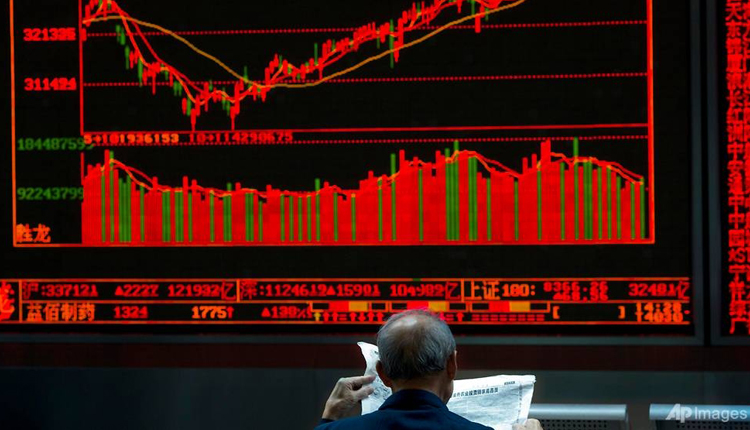Asian markets dropped Thursday afternoon as the main yield curve in U.S. Treasurys inverted, triggering fears over the state of the U.S. economy.
In mainland China, stocks fell by the afternoon. The Shanghai composite shed 0.62 percent, while the Shenzhen component declined 0.73 percent and Shenzhen composite slid 0.754 percent. Hong Kong’s Hang Seng index slipped 0.17 percent.
In Japan, the Nikkei 225 fell 1.56 percent, while the Topix index dropped 1.33 percent. Australia’s S&P/ASX 200 also tumbled 2.61 percent, as data on Thursday showed the jobless rate unchanged despite employment numbers in the country soaring past expectations in July.
The MSCI Asia ex-Japan index shed 0.8 percent overall.
Markets in South Korea and India are closed on Thursday for holidays.
Treasury yield curve inversion
Investors watched the bond market on Thursday, after the yield on the benchmark ten-year Treasury note briefly broke below the 2-year rate overnight, an odd bond market phenomenon that has historically been a reliable indicator of economic recessions. The yield on the 30-year Treasury bond was also sent to a new record low on Wednesday.
The yield inversion between the 10 and 2 year Treasury note happened again in the afternoon of Asian trading hours, with the yield on the 10-year Treasury note last at 1.5471 percent, as compared to the 2-year rate at 1.5565 percent. The 30 year Treasury bond also touched fresh historic lows on Thursday.
“We shouldn’t ignore that this historically reliable indicator of the economy is telling us a recession may be looming. But markets have changed significantly in the last decade and yield curve inversion is not the harbinger it once was,” Kerry Craig, global market strategist at J.P. Morgan Asset Management, wrote in a note.
“Yield curve inversion is flashing a warning sign – investors should check their portfolios are resilient. But it’s not a reason to panic or to lean into the sell-off,” Crais said. “The market corrections can also offer fresh opportunities to pick up equities at more reasonable valuations.”
Bank shares decline
Bank stocks across the region mostly fell on Thursday, after financials stateside saw a rout overnight amid the market turmoil on Wall Street.
In Japan, shares of Mitsubishi UFJ Financial Group slipped 1.29 percent and Nomura fell 1.31 percent. Hong Kong-listed shares of HSBC declined 1.7 percent, while China Construction Bank advanced 0.89 percent.
Over in Australia, the financial subindex declined more than two percent as the so-called Big Four banks saw their stock decline: Australia and New Zealand Banking Group fell 2.96 percent, Commonwealth Bank of Australia shed 2.38 percent, Westpac slipped 2.91 percent and National Australia Bank dropped 2.75 percent.
Yuan watch
The People’s Bank of China set its official midpoint reference for the yuan at 7.0268 per dollar on Thursday, weaker than analysts’ expectations.
It was the sixth consecutive session where the People’s Bank of China (PBOC) fixed the midpoint at a level weaker than the psychologically important 7-yuan-per-dollar mark.
The onshore Chinese yuan last traded at 7.0278 against the greenback, while its offshore counterpart changed hands at 7.0413 per dollar.
Overnight stateside, the Dow Jones Industrial Average plunged 800.49 points to close at 25,479.42 — its worst percentage drop of the year and fourth-largest point drop of all time.
The S&P 500 fell 2.93 percent to finish its trading day at 2,840.6, while the Nasdaq Composite closed 3.02 percent lower at 7,773.94.
The moves came amid rising fears over the global economy, with China reporting weaker than expected industrial output for July and Germany posting a negative gross domestic print for the second quarter.
Currencies and oil
The U.S. dollar index, which tracks the greenback against a basket of its peers, was at 97.930 after surging from levels below 97.8 yesterday.
The Japanese yen, widely viewed as a safe-haven currency, traded at 105.87 against the dollar after strengthening sharply from levels above 106.5 in the previous session. The Australian dollar changed hands at $0.6777 after touching an earlier low of $0.6743.
Oil prices slipped in the afternoon of Asian trading hours after seeing sharp losses on Wednesday. International benchmark Brent crude futures declined 0.72 percent to $59.05 per barrel, while U.S. crude futures shed 0.6 percent to $54.90 per barrel.
Source: CNBC
